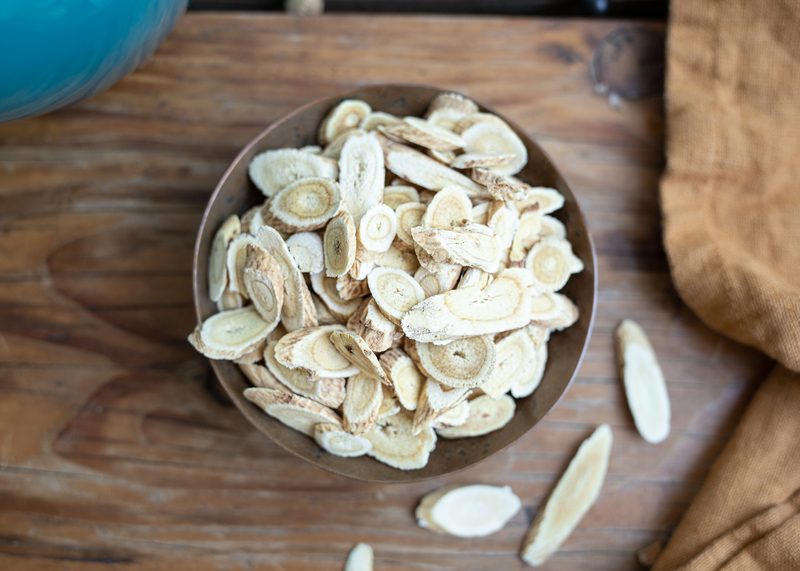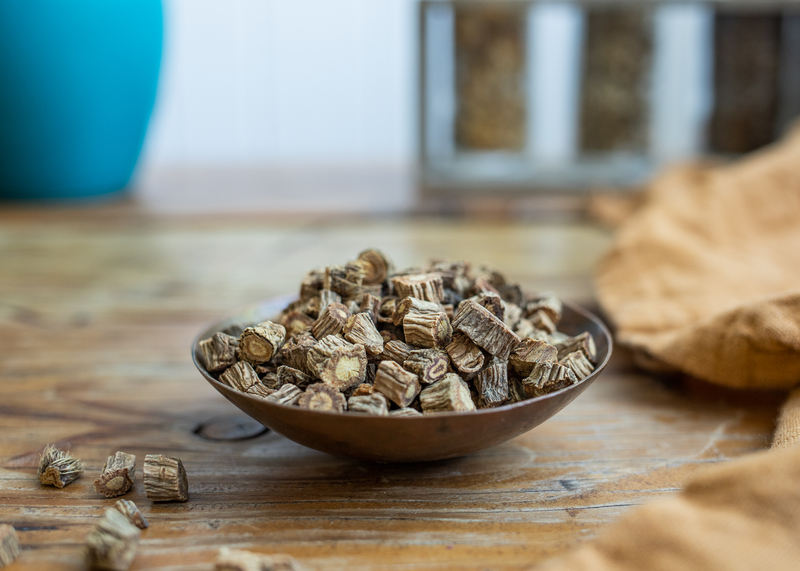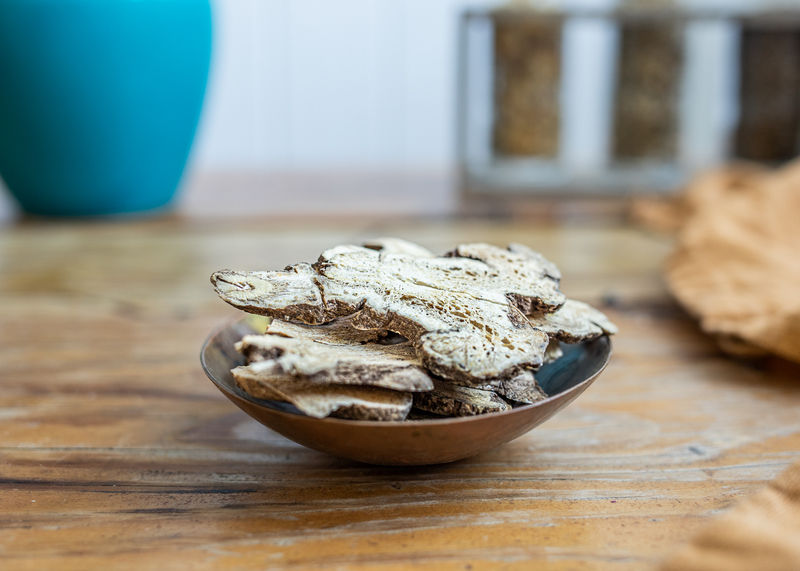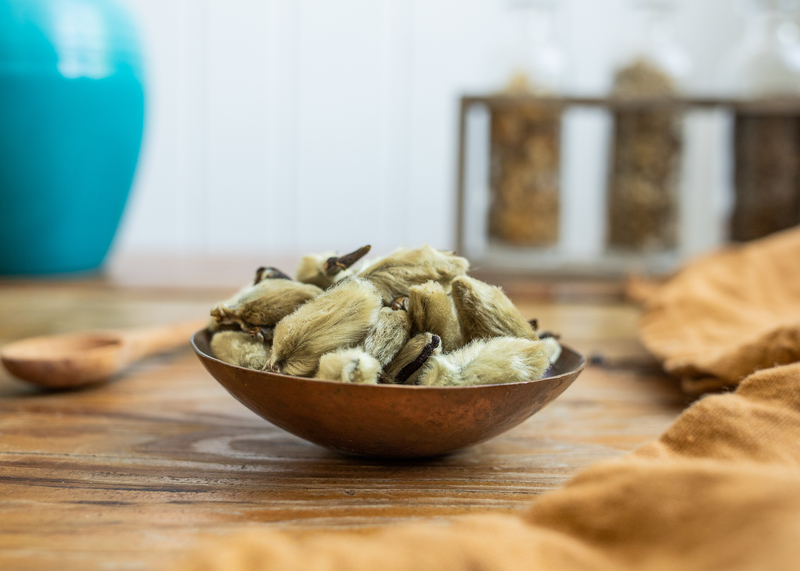
Spring and early summer are seasons of renewal and growth; however, it also means “allergy season” for millions worldwide. Fortunately, there are time-tested, safe, and effective botanicals that can offer support.
Let’s explore the manifestation of seasonal allergies from a traditional Chinese medicine (TCM) lens, discuss how the Lung, Kidney, and Spleen are affected, and review some of the best botanicals for seasonal discomfort.
Understanding Allergies through TCM
Seasonal allergies often manifest with:
- Runny nose
- Congestion
- Sneezing
- Hives or itchy skin
- Itchy eyes
- Sinus headache
These conditions are often caused by an overactive immune reaction to the excess pollen, spores, and increased wind (Chen & Chen, 2012) that are common in spring. If there is already constitutional disharmony within the body, these environmental elements could create issues for the body, mind, and spirit.
Lung System
In TCM, the nasal cavity is the doorway to the Lung system. The Lung system also controls the dispersion of wei qi, or the immune barrier, which is nourished by air, food, and water and protects the body from external pathogens (Chen & Chen, 2012). Since the Lung is considered the first line of defense, it’s not surprising that it’s often affected by one of the 6 “qi evils.”
- Wind
- Cold
- Heat
- Damp
- Dryness
- Fire
When looking at seasonal allergies, we often notice the presence of Wind and Damp - sneezing and runny nose. Wind manifestations have an unpredictable nature, coming and going without apparent cause. The sneezing that accompanies seasonal allergies frequently fits this description, suggesting the presence of Wind.
Dampness, an issue with bodily fluids, often appears in mucus and phlegm. Those with excess Dampness may have a runny nose and/or a wet cough. Those with deficient Dampness (dryness) may experience the opposite - congestion. Deficient Lung qi can also decrease the body’s ability to resist external pathogens, fueling the fire of seasonal allergies.
The Lung system is the container of Dampness and Phlegm evils.
Lung Invasion Patterns & Complications
With seasonal allergies, the body may experience an external invasion pattern, like Wind invasion. Seasonal conditions may also arise from internal complications, like Heat or qi imbalance.
External Invasion Patterns
Wind Evil Invading the Lung: Manfiests as sneezing and itchy nose with seasonal allergies and may be accompanied by clear discharge, headache, scratchy throat, and floating pulse.
Wind-Cold Evil Invading the Lung: Similar to “Wind evil invading the Lung” with additional issues like sore throat, slight fever, general body aches, cough, loss of smell, pale tongue with thin white fur, and a floating pulse.
Internal Complications
Lung Heat: Manifests as dry throat issues with seasonal allergies and may include thick, yellow discharge, fever, thirst, constipation, and dark, scanty urine. The tongue is also dry and red with yellow fur, and the pulse is fast.
Lung Qi Deficiency: Seasonal allergy issues may include clear nasal discharge and sneezing with additional complications like tiredness after physical exertion, exhausted spirit, low voice, no desire to speak, and pale complexion. The tongue may be pale with thin white fur, and the pulse is weak.

Herbs + Botanicals for Lung Support
Due to the nature of seasonal allergies, botanicals may help soothe irritations.
Seasonal Allergies
- You Ji Huang Qin (Scutellaria baicalensis): Chinese skullcap (有機黃芩(圆切) enters through the Lung, Gallbladder, Stomach, and Large Intestine channels. It is helpful for those experiencing Lung heat and may support mucus clearance in the respiratory tract (Chen & Chen, 2012). In addition to skullcap’s ability to clear heat, it may also balance the immune response, soothing other allergy-related complications.
- Xin Yi Hua (Magnolia spp.): Magnolia flower (辛夷花) enters through the Lung and Stomach channels. It has an affinity for opening the nasal cavity and clearing nasal obstructions due to wind-cold (Chen & Chen, 2012). It may be used for recurring seasonal allergies.
- Cang Er Zi (Xanthium sibiricum): Xanthium fruit (蒼耳子-驗測) enters through the Lung and Liver channels. It is often used to address nasal cavity conditions. It may also alleviate discomfort associated with sinus headaches (Chen & Chen, 2012). Research shows that xanthium fruit may have the ability to quell nasal itching and sneezing frequency.
- Bai Zhi (Angelica dahurica): Fragrant angelica root (白芷-驗測) enters through the Lung, Stomach, and Spleen channels. It dispels wind-cold by slowing nasal discharge and clearing congestion (Chen & Chen, 2012). The active constituents in fragrant angelica root may soothe an overactive immune response caused by seasonal allergies.
- Bi Yan Wan: Jade Dragon - Cool Sinus (鼻炎丸) may calm seasonal allergy conditions that manifest as nasal blockages, irritated eyes, and sneezing. It is best used when Wind and Heat are present. Ingredients include: Xin Yi Hua, Cang Er Zi, Huang Bai, Lian Qiao, Ye Gan Cao, Wu Wei Zi, Zhi Mu, Jing Jie, Jie Geng, Ju Hua, Bai Zhi, Fang Feng
Immune Support
- Huang Qi (Astragalus membranaceus): Astragalus root (黃芪) enters through the Lung and Spleen channels. It has an affinity for tonifying wei qi that may be expressing deficiency signs (Chen & Chen, 2012). Research shows that astragalus root may be able to balance the immune system by stimulating immune functions.
- Sang Ju Wan: Jade Dragon - Early Defense (桑菊丸) supports upper respiratory issues when cold or allergy complications first arise. Best used in the early stages of seasonal conditions. Ingredients include: Sang Ye, Jie Geng, Lu Gen, Lian Qiao, Ku Xing Ren, Ju Hua, Ye Gan Cao, Bo He
Spleen System
The Spleen system governs the “transportation and transformation” of fluids. It sends clean, nutrient-rich fluid (with the support of the Kidney system) up to the Lungs via an “upward mist.” This keeps the lungs nourished and healthy. However, if the Spleen is experiencing imbalance, Dampness and mucus-related issues may occur. Since the Spleen transports these fluids up to the Lung system, mucus may set up residence in the lungs, blocking the nasal pathway and causing coughing and congestion.
Spleen Internal Complications
Spleen Qi Deficiency: Clear nasal discharge and incessant sneezing may appear with seasonal allergies. Other signs of Spleen qi deficiency may involve fatigue, poor appetite with a craving for sweets, and loose stools or diarrhea. The tongue may be pale with toothmarks on the sides and have white fur. The pulse may be weak, deficient, slippery, and slow.

Herbs + Botanicals for Spleen Support
Botanicals for spleen support may calm irritations and support the immune processes that strengthen the system against future seasonal manifestations.
Seasonal Allergies
- Bai Zhi (Angelica dahurica): Fragrant angelica root (白芷-驗測) enters through the Lung, Stomach, and Spleen channels. It dispels wind-cold by calming nasal discharge and clearing congestion (Chen & Chen, 2012). The active constituents in fragrant angelica root potentially soothe the overactive immune response caused by seasonal allergies.
- Immune Support
- Huang Qi (Astragalus membranaceus): Astragalus root (黃芪) enters through the Spleen and Lung channels. It has an affinity for tonifying wei qi that may be expressing deficiency signs (Chen & Chen, 2012). Research shows that astragalus root may help regulate the immune system by stimulating immune functions.
- Bai zhu (Atractolydes macrocephala): Atractylodes rhizome (白朮) enters through the Spleen and Stomach channels. It supports manifestations of wei qi deficiency by strengthening wei qi and tonifying the Spleen (Chen & Chen, 2012). Scientific studies suggest that its polysaccharide content may be the reason for its immune-supporting effects.
- Fang Feng (Saposhnakovia dicaricata): Siler root (防風) enters through the Liver, Spleen, and Urinary Bladder channels (Chen & Chen, 2012). It is often used for strengthening wei qi associated with wind-cold manifestations. Various studies show that siler root may dispel Wind and remove Dampness.
Kidney System
In TCM, the Kidney system is the powerhouse and seat of “innate essence,” or the original qi (vital energy) you’re born with. Within the Kidney is Yang qi, which provides warmth and promotes proper organ functioning, and Yin qi, which provides moisture and nourishment to the organs.
The Kidney, Spleen, and the Lung have a close, interconnected relationship. When the Spleen is ready to transport nutrient-rich fluid, the Kidney warms and evaporates the fluid to be sent upwards to moisten the lungs. A deficiency of Kidney yang qi may result in the improper metabolism of fluids and cause qi deficiency in the Lung.
The presence of sneezing can also indicate an issue with the Kidney system. The Su-Wen, an ancient medical text that carries the foundational doctrine of TCM, states, “[I]f the Kidney energy is damaged, it will cause yawning and sneezing.” Due to the interwoven relationship of the Kidney, Spleen, and the Lung, if the Kidney has an imbalance, it will also manifest in the other systems.
Kidney Internal Complications
Kidney Yang Deficiency: Experiences may include itchy nose and frequent sneezing, as well as kidney issues like backaches, cold extremities, low sex drive, premature graying of hair, premature ejaculation, excessive leucorrhea, impotence, and frequent urination. The tongue may be pale and enlarged with white fur, and the pulse may be deep and thin.
Kidney Yin Deficiency: Seasonal allergy issues may manifest as nasal congestion and heavy nasal discharge with sneezing. Other complications may include backache, low energy, night sweats, and dry throat. The tongue may be red with little or no fur or thin yellow fur in cases of deficiency heat.
In Closing, with the blossoms of spring come the frustrations of wind. Various TCM botanicals may support the body by calming seasonal complications or strengthening the system against external invasions.
If you’re interested in learning more about TCM botanicals for seasonal allergies or have any questions, please contact us at questions@nuherbs.com. All inquiries are welcome!
These statements have not been evaluated by the Food and Drug Administration. Our product and website content are not intended to diagnose, treat, cure, or prevent any disease.
References
Chen, J. K., Chen, T. T., & Crampton, L. (2012). Chinese Medical Herbology and Pharmacology. Art of Medicine Press, Inc.
Dashtdar M, Dashtdar MR, Dashtdar B, Kardi K, Shirazi MK. The Concept of Wind in Traditional Chinese Medicine. J Pharmacopuncture. 2016 Dec;19(4):293-302. doi: 10.3831/KPI.2016.19.030. PMID: 28097039; PMCID: PMC5234349.
Jun X, Fu P, Lei Y, Cheng P. Pharmacological effects of medicinal components of Atractylodes lancea (Thunb.) DC. Chin Med. 2018 Nov 27;13:59. doi: 10.1186/s13020-018-0216-7. PMID: 30505341; PMCID: PMC6260578.
Kolasani A, Xu H, Millikan M. Determination and comparison of mineral elements in traditional Chinese herbal formulae at different decoction times used to improve kidney function--chemometric approach. Afr J Tradit Complement Altern Med. 2011;8(5 Suppl):191-7. doi: 10.4314/ajtcam.v8i5S.25. Epub 2011 Jul 3. PMID: 22754074; PMCID: PMC3252708.
Li D, Wu L. Coumarins from the roots of Angelica dahurica cause anti-allergic inflammation. Exp Ther Med. 2017 Jul;14(1):874-880. doi: 10.3892/etm.2017.4569. Epub 2017 Jun 8. PMID: 28673013; PMCID: PMC5488689.
Mao D, He Z, Li L, Lei Y, Xiao M, Zhang H, Zhang F. Recent Progress in Traditional Chinese Medicines and Their Mechanism in the Treatment of Allergic Rhinitis. J Healthc Eng. 2022 Apr 11;2022:3594210. doi: 10.1155/2022/3594210. PMID: 35444784; PMCID: PMC9015857.
Peng, W., Ming, Q. L., Han, P., Zhang, Q. Y., Jiang, Y. P., Zheng, C. J., Han, T., & Qin, L. P. (2014). Anti-allergic rhinitis effect of caffeoylxanthiazonoside isolated from fruits of Xanthium strumarium L. in rodent animals. Phytomedicine : international journal of phytotherapy and phytopharmacology, 21(6), 824–829. https://doi.org/10.1016/j.phymed.2014.01.002
Unschuld, P. U., Tessenow, H. (2011). Huang Di Nei Jing Su Wen: An Annotated Translation of Huang Di’s Inner Classic – Basic Questions: 2 Volumes. Ukraine: University of California Press.
Wu XN. Current concept of Spleen-Stomach theory and Spleen deficiency syndrome in TCM. World J Gastroenterol. 1998 Feb;4(1):2-6. doi: 10.3748/wjg.v4.i1.2. PMID: 11819216; PMCID: PMC4767755.
Zhang Y, Fu J, Zhou Z, Zhang Y, Chen Y, Song A. Exploring the Relationship between Allergic Rhinitis and Constitution Based on the "Traditional Chinese Medicine Constitution Theory". Evid Based Complement Alternat Med. 2022 Aug 24;2022:9230317. doi: 10.1155/2022/9230317. PMID: 36062169; PMCID: PMC9433264.


